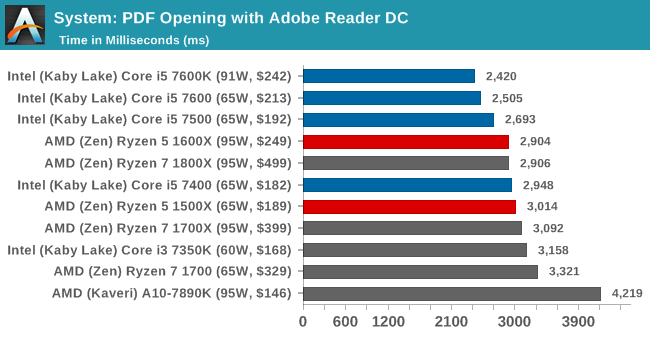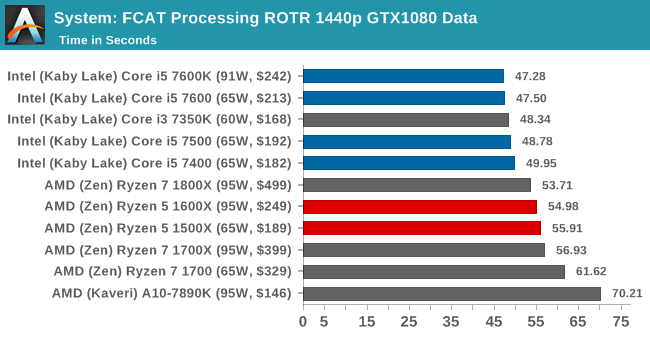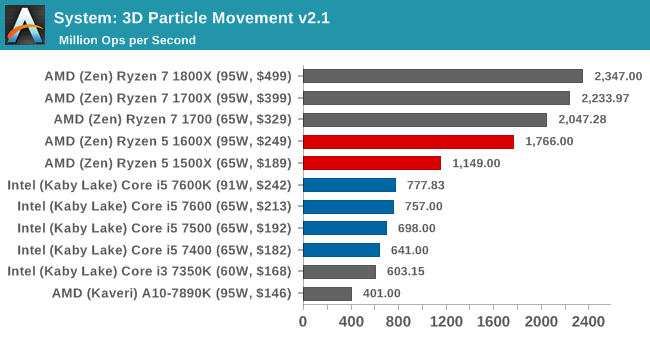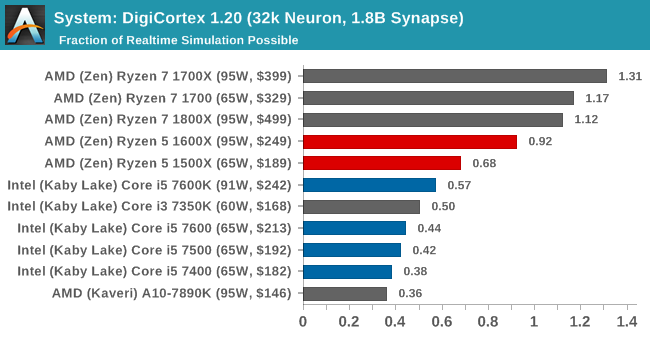The AMD Ryzen 5 1600X vs Core i5 Review: Twelve Threads vs Four at $250
by Ian Cutress on April 11, 2017 9:00 AM ESTBenchmarking Performance: CPU System Tests
Our first set of tests is our general system tests. These set of tests are meant to emulate more about what people usually do on a system, like opening large files or processing small stacks of data. This is a bit different to our office testing, which uses more industry standard benchmarks, and a few of the benchmarks here are relatively new and different.
PDF Opening
First up is a self-penned test using a monstrous PDF we once received in advance of attending an event. While the PDF was only a single page, it had so many high-quality layers embedded it was taking north of 15 seconds to open and to gain control on the mid-range notebook I was using at the time. This put it as a great candidate for our 'let's open an obnoxious PDF' test. Here we use Adobe Reader DC, and disable all the update functionality within. The benchmark sets the screen to 1080p, opens the PDF to in fit-to-screen mode, and measures the time from sending the command to open the PDF until it is fully displayed and the user can take control of the software again. The test is repeated ten times, and the average time taken. Results are in milliseconds.

Opening PDFs using Adobe is significantly single threaded, hence why Intel takes the win here for the most part - the 7400 is slightly lower on frequency, enough for the 4.0 GHz Ryzen parts to push ahead.
FCAT Processing
One of the more interesting workloads that has crossed our desks in recent quarters is FCAT - the tool we use to measure stuttering in gaming due to dropped or runt frames. The FCAT process requires enabling a color-based overlay onto a game, recording the gameplay, and then parsing the video file through the analysis software. The software is mostly single-threaded, however because the video is basically in a raw format, the file size is large and requires moving a lot of data around. For our test, we take a 90-second clip of the Rise of the Tomb Raider benchmark running on a GTX 980 Ti at 1440p, which comes in around 21 GB, and measure the time it takes to process through the visual analysis tool.
Similarly, FCAT is single threaded as it analyzes frame-by-frame. The extra frequency helps Intel here.
3D Particle Movement v2.1
This is the latest version of the self-penned 3DPM benchmark. The goal of 3DPM is to simulate semi-optimized scientific algorithms taken directly from my doctorate thesis. Version 2.1 improves over 2.0 by passing the main particle structs by reference rather than by value, and decreasing the amount of double->float->double recasts the compiler was adding in. It affords a ~25% speed-up over v2.0, which means new data.
DigiCortex 1.20
Despite being a couple of years old, the DigiCortex software is a pet project for the visualization of neuron and synapse activity in the brain. The software comes with a variety of benchmark modes, and we take the small benchmark which runs a 32k neuron/1.8B synapse simulation. The results on the output are given as a fraction of whether the system can simulate in real-time, so anything above a value of one is suitable for real-time work. The benchmark offers a 'no firing synapse' mode, which in essence detects DRAM and bus speed, however we take the firing mode which adds CPU work with every firing.
Agisoft Photoscan 1.0
Photoscan stays in our benchmark suite from the previous version, however now we are running on Windows 10 so features such as Speed Shift on the latest processors come into play. The concept of Photoscan is translating many 2D images into a 3D model - so the more detailed the images, and the more you have, the better the model. The algorithm has four stages, some single threaded and some multi-threaded, along with some cache/memory dependency in there as well. For some of the more variable threaded workload, features such as Speed Shift and XFR will be able to take advantage of CPU stalls or downtime, giving sizeable speedups on newer microarchitectures.

Because parts of Photoscan are very multithreaded, such as the first stage, there's plenty of scope for the Ryzen CPUs to pull ahead here.













254 Comments
View All Comments
Meteor2 - Wednesday, April 12, 2017 - link
Benchmarks: I love the new Chromium compilation and straightforward 4K h264->h265 tests. Bravo.Lehti - Wednesday, April 12, 2017 - link
As it is, the Ryzen 5 lineup is a compelling purchase, even for us European who usually get awful deals with PC components. If AMD released it as an APU lineup, however, this would be a no-brainer for everyone. And yes, I know that Ryzen 5 chips are basically binned Ryzen 7s, but still...vladx - Wednesday, April 12, 2017 - link
Can't agree there, I'm from Europe and the 7600k is only around $20 more expensive than the Ryzen 1500x and it beats it in a lot of games and also fares better in office workloads. And that $20 gets at least even out when you put in consideration the Intel B250 motherboards which are $20-40 than competing AMD B350 mainstream offers.Meteor2 - Wednesday, April 12, 2017 - link
Where in Europe are you? In the UK the R5 1500X is $80 cheaper than the the i5-7600K.t.s - Wednesday, April 12, 2017 - link
You're focusing in single threaded apps / games, again, and again, and again. Not everyone use they computer for ST apps / games. And when you factored it in, R5 is very compelling product.vladx - Thursday, April 13, 2017 - link
That's true but enthusiasts and prosumers are maybe 2% of the market, the rest 98% won't use their PC for more than browsing the web, watching movies and basic office work.deltaFx2 - Friday, April 14, 2017 - link
@vladx : That's true but if browsing the web, watching movies, and basic office work is all you do, Excavator is perfectly fine for you. I expect people buying 7700k or R5 or even some i5s have some workloads that justify the expense. This is especially true of Ryzen as the current crop need an external GPU. IIRC Raven Ridge desktop parts come only next year.Sages - Wednesday, April 12, 2017 - link
Would it be possible to do another power review with ryzen like you guys did with Carrizo in 2016? Or do you guys not have the equipment for that? For me as a electrical engineering student that article was very interesting. Keep up the good work!!TheJian - Wednesday, April 12, 2017 - link
"A side note on OS preparation. As we're using Windows 10, there's a large opportunity for something to come in and disrupt our testing. So our default strategy is multiple: disable the ability to update as much as possible, disable Windows Defender, uninstall OneDrive, disable Cortana as much as possible, implement the high performance mode in the power options, and disable the internal platform clock which can drift away from being accurate if the base frequency drifts (and thus the timing ends up inaccurate)."Or you could have just used Win7 since 1/2 the world still uses it and don't plan on quitting it until well after 2020. Until I see someone actually REVIEW these chips with win7, they won't get my money. Vulkan runs on everything, I have no need for dx12 (all everything you guys just mentioned plus all the tracking etc etc). With no apu crap involved here, you should test win7 if only to show if there is any differences. Considering most of the issues are bios fixes it seems (motherboard), no reason to abandon win7 in testing. Again, half of your readers are using it, more than 2x win10, and many of these people are stuck on it because they don't know how to get back to win7...ROFL
I can't wait for everyone to drop dx12 once whatever they're working on currently is done (many too far along to quit right now in a current game build). I think we'll see many more Vulkan/dx11 only announcements later this year. No point in a dev supporting an OS (dx12 I mean) that was given away for a year and still can't hit 1/2 of win7's users, not to mention many woke up an were accidentally "upgraded" to win10 with no ability to get back reliably. Uninstalling it doesn't always work (and many don't own win7 discs to get back in cases like Dell etc for some people) ;)
But hey, keep acting like win7 doesn't exist much to the chagrin of your readers.
vladx - Wednesday, April 12, 2017 - link
"Until I see someone actually REVIEW these chips with win7, they won't get my money."Who are you punishing here, but yourself? You probably shouldn't anyway because neither Ryzen or Kabylake are supported on Win7.